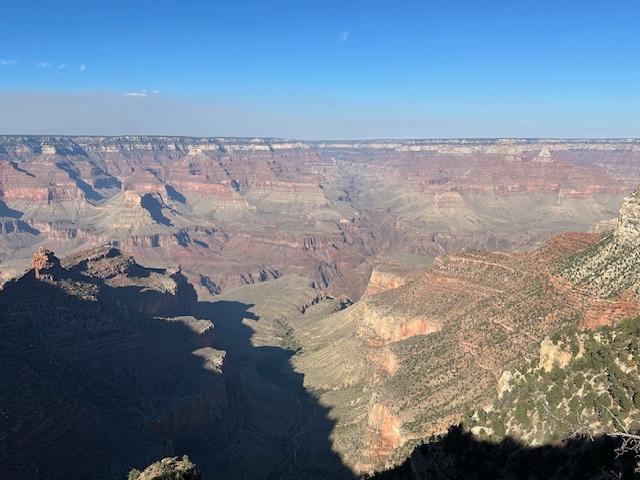
It’s bitterly cold in Minnesota this week, and it’s making me think about our latest trip someplace warm. Our family went to Arizona to see the Grand Canyon in October, and we all loved it. In fact, we all rated it as better than Disney in some respects.
We arrived in Phoenix when the weather was turning cool in Minnesota, and Phoenix itself was hot. We rented a car at the airport and drove up through the mountains to Sedona, then on to Williams, Az. From Williams, we took the train into Grand Canyon National Park, where we stayed as Maswik Lodge for two days before reversing out trip back to Phoenix.
What made it more fun than Disney? I think it might have started with the train. We purchased tickets on the Grand Canyon National Railway, staying in their hotel the night before and the night after our trip. The station in Williams anchors a train line that runs right into Grand Canyon National Park, and it’s been there for more than 100 years. The cars vary from old nineteenth century Pullman cars to modern luxury cars, and the ticket prices vary accordingly. We decided we preferred air conditioning when riding in the desert (a wise choice), and bought tickets to the 1950s car.
We arrived the night before our ride, checked into the Railway Hotel, and ate from the buffet at the Fred Harvey Restaurant next to the depot. There, we started learning about the legacy of Fred Harvey, a nineteenth century entrepreneur who brought fine dining to the west and southwest, and imported young women of impeccable character to serve the travelers at his hotels and restaurants. These “Harvey girls” married locally, helping to establish communities at the stops along the route that Harvey hosted.
One of these original Harvey properties actually exists in Grand Canyon National Park.
We enjoyed excellent food (I had beef tenderloin) and live music before heading back for some swimming at the hotel pool. The excitement about the train built as the night wore on, and we were up early the next day for breakfast at the buffet.
We also took advantage of the restaurant’s packed lunch service. We were told that dining in the park could be challenging, and restaurants were not always open. For a reasonable $17, we got an insulated lunch bag filled with a sandwich, bottled water, trail mix, cookie, fruit, and cheese stick. The lunch bag itself, emblazoned with the Grand Canyon National Railway logo, made it worth the price, and as our day unfolded, we found the snacks and water to be invaluable.
Once we’d picked up our lunches, we went to the depot. Our luggage was handled separately, and frankly, I felt a little spoiled by not having to haul luggage onto a train. I think that might have been my favorite part, personally. We were able to just take our lunch bags and backpacks to the depot. There, we were treated to a skit put on by a crew of terribly inept cowboys. We immediately suspected shenanigans, especially since they kept getting up after getting shot, and our suspicions were confirmed when some of the crew–including the sheriff–followed us all onto the train. We found our seats easily, and as our train left the station, our porter treated us to an introduction to the train, the Park, and the history of the area. He emphasized drinking lots of water, again, and I finally caught a clue. We were heading into a desert.
Definitely time to buy a water bottle or four. I bought four water bottles on the train, and they proved to be extremely helpful to our staying hydrated the rest of the weekend.
The train also featured a singing cowboy who started a sing-a-long in our car. We already were having a great time when the train pulled into the station. Our first views of the Grand Canyon village were of a pretty little mountain town. We had tickets for a tour right away, and we went to find our bus. Once on the bus, we opened up our sack lunches for a snack and a drink, and chattered at each other as the bus took us upon the South Rim to our first stop: Mojave Point.
Friends, I cannot describe the experience of seeing the Grand Canyon for the first time. I can tell you that every single person on the bus said, “Wow!”, involuntarily, when our bus came around the corner of the mountain and we saw it for the first time. It’s vast, layered with stratified rock, a ribbon of river at the very bottom, which is so far away that it’s hard to recognize its scope. We were stunned, and a little afraid. When we got out of the bus to walk out on the path, I kept my children firmly away from the edges and railings.
But that view? Worth every penny.
We took lots of pictures; my girls had their iPads along and were taking video of everything. Our tour took more than an hour, and took us to all the main high points along the South Rim. When it returned us to the village, it took us to Maswik Lodge, which was our lodging for the night.
Maswik features clean rooms that have their own entrances and exits to the outside. Ours had a patio off the back into the woods from which we were able to view deer and other forms of wildlife. We could walk up to the food court in the main lodge any time we were hungry, and take a trolly bus to any other spot in the park on our whim. If we were still hard core backpackers, we could have outfitted ourselves easily with what we needed to hit the trail.
As it was, we decided to walk gentler trails along the South Rim, from one point to another, and to spend some time at the big Visitor’s Center with its indoor and outdoor exhibits. We also made time to send postcards from the village post office and just relax to the sound of the wilderness around us.
We also dug into the area’s stories, exploring the original Fred Harvey property there and eating at its cafe. When we left on the train to head back to Williams, two days later, we felt invigorated.
Then we were robbed on the train. Of course, these were the same inept crew as before, and I was able to buy them off with one shiny gold U.S. dollar coin. But still, it made us giggle as we saw the sun set from the train window over the mountain.
I’m sure we’ll return.





